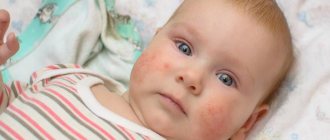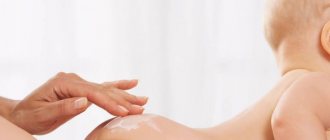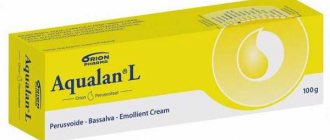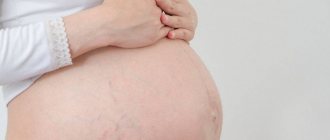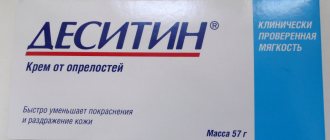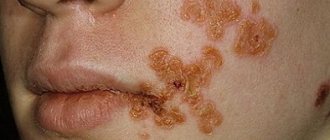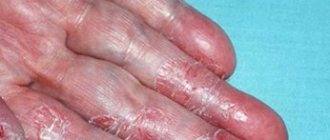Quick transition Treatment of atopic dermatitis in children
Atopic dermatitis is a disease in which the skin becomes very itchy, irritated, red, dry, and uneven.
Atopic dermatitis is a common skin disease that is part of a group of skin diseases combined under the broader term “eczema.”
There are other types of eczema: nummular, dyshidrotic, etc. However, the terms “eczema” and “atopic dermatitis” are often used interchangeably.
As a rule, atopic dermatitis debuts in infancy (3–6 months) and occurs in 15–20% of children. Most often, its course is most severe in the first 1–3 years of life; as the child grows older, the severity of the disease decreases. Atopic dermatitis usually disappears by school age or puberty. However, in some people the disease can persist throughout their lives, occasionally worsening, or appearing constantly.
What are the causes of the disease?
It is necessary to distinguish between the cause and triggers of atopic dermatitis.
The reason is not fully known to modern science; the main version is a set of genetic, immune and skin changes, in particular, a deficiency of the skin protein filaggrin, which is responsible for retaining moisture in the skin.
The triggers of atopic dermatitis are very diverse, atopic skin is overly sensitive to irritation, so exacerbation can be caused by increased sweating, heat, rough clothing, detergents, dry air, etc. Children with atopic dermatitis may simultaneously have allergies to food, household or other animals, dust mites, tree and grass pollen - these allergens can also be triggers for exacerbations.
In general, atopic dermatitis has a wave-like course, periods of exacerbations (most often occurring for unobvious reasons or for no reason) are replaced by periods of remission - hence there is a great temptation to associate exacerbations with factors that are not directly related to the disease, and vice versa - to attribute healing properties to completely extraneous factors (for example, a diet that parents started by mistake or out of desperation).
It is impossible not to mention the established harmful domestic tradition of calling atopic dermatitis allergic (usually associating it with an allergy to cow’s milk protein) and treating it with diets (a strict “hypoallergenic” diet for a nursing mother, and/or a hydrolysis/amino acid mixture for a child). Indeed, if a child has an intolerance to cow's milk proteins, it may aggravate or cause atopic dermatitis, but not vice versa. Not every child with atopic dermatitis has an intolerance to cow's milk proteins or any other allergens. This means that by prescribing a diet, or an expensive and unpleasant-tasting mixture, the doctor adds problems to the family without helping them. In most cases of atopic dermatitis, identifying allergies and excluding allergens does not provide any benefit.
Causes of allergic dermatitis
Allergic dermatitis includes many inflammatory processes on the skin associated with the negative effects of irritants, most often food allergens. Very often, the disease is provoked by certain foods - the pathogen enters the circulatory system through the gastrointestinal tract. It is also worth noting indirect causes that can also cause symptoms of allergic dermatitis. These include:
- genetic predisposition;
- hormonal disorders;
- deficiency of vitamins and minerals in the body;
- unbalanced diet;
- stress and nervous tension;
- mental disorders;
- physical overload;
- autoimmune diseases;
- disruptions in stomach functions.
The environment also influences the development of the disease - in regions with poor ecology there are more patients with this pathology than in areas with a favorable environmental situation.
Manifestations of atopic dermatitis
Skin symptoms and location of lesions vary in children of different ages. Common symptoms are the appearance of red, dry, itchy patches on the skin that occur as a result of inflammation. There is always itching - from mild to unbearable, disrupting sleep and appetite. Frequent scratching may cause scratches (scratching), oozing (separation of serous exudate through tiny defects in the epidermis), crusting, or erosion due to secondary infection. Sometimes, if atopic skin lesions, lesions from chronic pruritus and secondary infections last for many weeks, areas of skin atrophy (scars, hypopigmentation/hyperpigmentation, thinning or thickening of the skin) may develop.
In infants, atopic dermatitis usually affects the face, scalp, arms and legs. In older children, as a rule, only the elbows, popliteal fossae and wrists are affected. In some children with severe disease, the entire body may be affected. Eczema causes severe itching, which can in turn lead to a number of secondary problems: sleep disturbances, weight loss, depression (in the child or in the adult who cares for him), etc.
Symptoms usually worsen in the autumn-winter period (this fact is usually associated with the inclusion of central heating and more severe external climatic conditions) and improve in the spring-summer period, as well as in seaside resorts (this is usually associated with the abundance of ultraviolet radiation and milder climatic influences on affected skin). Typically, the most severe course of the disease is observed in children aged 6–18 months (in winter, exacerbations are more frequent and severe, in summer - less frequent and milder), then from year to year, exacerbations become less frequent and milder. By school, most children recover or have symptoms that do not reduce their quality of life.
A modern view of basic skin care for children with atopic dermatitis
Introduction
Atopic dermatitis (AD) is a chronic inflammatory skin disease.
AD, as the most common of the dermatitis, affects up to 20% of children and 1–3% of adults in most countries of the world [2]. In 50% of cases, the first symptoms of AD appear in the first 6 months. life, and in 90% - up to 1 year [3]. The exact mechanisms of AD pathogenesis remain unclear to date. It is generally accepted that the occurrence of AD is associated with a genetically determined violation of the protective barrier of the skin, disruption of the immune system, infection and environmental conditions. According to many studies, the leading mechanism in the pathogenesis of AD development is dysfunction of the epidermal barrier [4]. The goal of basic care (therapy) for AD is to restore and maintain the normal structure and function of the epidermal barrier, which helps prevent sensitization, infection and prolong remission. The latest scientific data on the violation of the protective functions of the skin allows us to better understand the course of the disease and select adequate therapy, including mandatory basic skin care. AD is primarily a problem for pediatricians, since the majority of patients are young children. Pediatricians care for approximately 30% of patients with AD [5], so they need information about the characteristics of such children and, first of all, about modern basic skin care products for their young patients. The purpose
of this work is to outline the role and significance of a simple algorithm for basic skin care for children with AD, as well as to consider the use of specialized cosmetics depending on the individual status of the patient’s skin and environmental conditions.
Epidermal barrier: structure and functions
The epidermal barrier is a collective concept that characterizes the state of the stratum corneum and the processes occurring in it [4]. The implementation of skin barrier functions is ensured through the interactions of various functional structures. Table 1 shows the main structural elements of the epidermal barrier and their functions.
The top layer of skin, the stratum corneum, is the main component of the epidermal barrier (Figure 1). It is the stratum corneum that serves as a barrier to the penetration of irritants and allergens into the deeper layers of the skin. The stratum corneum consists of flat cells without organelles and a nucleus - corneocytes, which are the final stage of differentiation of epidermal cells (keratinocytes). Its structural integrity is maintained by the presence of corneodesmosomes, which provide communication between corneocytes. According to ideas, the stratum corneum is a “brick - cement” structure, in which the role of building blocks is played by corneocytes, and the role of building mortar is played by lipids of the intercellular matrix. In an extension of the model, corneodesmosomes act as “iron rods” that impart proper rigidity to the structure [4]. Closer to the surface of the skin, corneodesosomes disappear, the stratum corneum becomes looser, and the corneocytes slough off.
Rice.
1. Normal state of the epidermal barrier The process of formation of the epidermal barrier begins at the border between the granular layer and the stratum corneum: lipid precursors are secreted from keratinosomes (lamellar bodies) along with enzymes [7]. Lipid matrix
is crucial in the stratum corneum performing its protective function.
The main purpose of this matrix is to prevent excessive evaporation of water through the epidermis and the development of xerosis. On the one hand, it ensures the integrity and elasticity of the skin, and on the other, it prevents the penetration of water-soluble substances into the deep layers of the epidermis. The lipid matrix includes 3 types of compounds: ceramides (sphingolipids), cholesterol and fatty acids in approximately equal molar quantities. Ceramides are polar lipids, which is why they are able to form ordered, densely packed bilayers – lamellae [8, 9]. It has been established that the lipid matrix contains both three-dimensional structured areas (called the crystalline phase) and unstructured areas (liquid crystalline phase), and the composition of these lamellar layers and their relative arrangement are equally important for performing the skin barrier function [8−10]. This matrix is resistant to dehydration factors, changes in temperature and pressure due to the heterogeneous composition of polar lipids and the high concentration of cholesterol, which stabilizes the liquid crystalline phase [11]. As the structure of the stratum corneum is ordered from the lower border to the surface of the skin, the water content also decreases; in the upper layers of the stratum corneum it remains only 10%. The stratum corneum is the only structure in the body where the intercellular space is filled mainly with lipids, not water! The chemical compounds that make up the intercellular matrix and ensure its hydration are formed through complex biochemical processes from a special protein - filaggrin, which, in turn, is formed from profilaggrin in the granular layer of the epidermis [12]. It should be noted that the functions of this protein are not the same in the lower and upper levels of the stratum corneum. Closer to the boundary with the granular layer, it contributes to the mechanical strength of the barrier by being involved in the formation of corneocytes. And in the upper parts of the stratum corneum, filaggrin breaks down into free amino acids, urea, sodium pyroglutamate, which are known as Natural Moisturizing Factor (NMF). These compounds are found in close proximity to corneocytes and play a critical role in ensuring normal levels of skin hydration. They also form an acidic environment necessary for the balance between the rate of keratinocyte maturation and the rate of corneocyte desquamation, as well as to reduce the likelihood of colonization of the skin surface by pathogenic microorganisms [12]. It should be noted that the synthesis of filaggrin and its breakdown is a very delicate balance between its production and proteolysis, on the one hand, and the inhibition of these processes, on the other. The integrity and functioning of the epidermal barrier largely depends on this balance. It is known that the level of skin acidity is a key factor in the formation of the epidermal barrier, the integrity of the stratum corneum and antimicrobial protection. Firstly, pH-dependent enzymes are involved in the formation of the epidermal barrier. The activity of serine proteases is an important part of the normal functioning of the skin: on the one hand, these enzymes are involved in the conversion of lipid precursors into their active form, on the other hand, they contribute to the destruction of corneodesmosomes and regulation of the desquamation process [13]. Secondly, lamellar layers form a crystalline structure only at pH 4.5–6.0 [14]. Thirdly, the synthesis of antimicrobial peptides in keratinocytes and cells of the sweat and sebaceous glands is also a pH-dependent process, as is the proliferation of bacteria on the surface of the epidermis [13, 15, 16].
young children the process of its maturation continues at least in the first year of a child’s life. This concerns structural differences in the structure (smaller cells, thinner layers) of the epidermis and dermis, NMF concentration, hydration levels and pH [17, 18]. In children under 2 years of age, on average, the epidermis is 20% thinner than in adults, and the stratum corneum is 30% thinner [19]. The composition of both NMF and lipid matrix changes. At birth, a child’s skin is drier than that of adults, but at the age of 3−24 months. her hydration level is significantly higher than that of adults. The skin quickly absorbs water, but loses it just as quickly. The formation of an acidic environment in the stratum corneum, as mentioned above, is the basis for the normal functioning of the epidermal barrier. Normally, the pH of the skin surface is 4–6; the deeper layers of the epidermis are approximately pH neutral [13]. In newborns, the pH of the skin surface is 6.5−7.5, but during the first 2 weeks of life the pH decreases and becomes approximately equal to that of adults. It should also be noted that the microbial landscape of the skin undergoes radical changes during the 1st year of life [17]. Infant skin exhibits increased permeability to irritants and is more susceptible to infection. Thus, the skin of children is different from that of adults, and the process of maturation of the epidermal barrier takes from several months to several years after birth.
Epidermal barrier disruption in AD
Changes in skin barrier functions in AD are associated with an increase in the permeability of the epidermal barrier and are characterized by changes in the structure and composition of the lipid matrix of the stratum corneum, as well as a decrease in the concentration of NMF components [4, 8–10]. The degree of disruption of the barrier integrity is determined by an increase in transepidermal water loss (TEWL) and a noticeable decrease in the level of skin hydration (Fig. 2).
Rice. 2. Violation of the epidermal barrier due to loss of moisture in AD
Table 2 shows the main violations of skin barrier functions in AD.
According to many authors, a genetic defect in filaggrin synthesis plays a leading role in barrier disruption, but it is not the only pathogenetic factor [3, 4, 9]. As the synthesis of filaggrin, a precursor of NMF components, decreases, skin hydration decreases, pH changes and, as a result, the activity of proteolytic enzymes decreases [13, 14]. Changes in pH on the surface of the stratum corneum lead to changes in the microbial landscape and frequent infections [15]. Marked changes in the lipid composition of the stratum corneum cause an increase in barrier permeability and TEWL [6, 20]. It has been noted that low levels of ceramides and an imbalance in their ratio are observed not only in areas of the affected skin: even in seemingly intact skin with AD, unfavorable changes occur, the level of its hydration is reduced, and xerosis is expressed [21, 22]. The uncontrolled and irrational use of external topical glucocorticosteroids contributes to the deterioration of the barrier functions of the skin: their long-term use causes skin atrophy [4, 23, 24]. Itching with AD
Dry skin in AD promotes the penetration of pathogenic microorganisms, allergens and irritants, which leads to the development of inflammation, accompanied by itching, scratching and further damage to the skin, triggering the “itch-scratch” cycle [25, 26]. Itching is one of the main problems that significantly worsens the quality of life in AD for both sick children and their parents. From 30 to 90% of children with AD experience itching, which worsens at night [26], and the child’s sleep is accordingly disturbed: up to 84% of children suffer from night awakenings [27].
Correction of the epidermal barrier: the role of specialized cosmetics
Research conducted over the past decades on the role of the epidermal barrier in the pathogenesis of AD has forced us to turn to the development of methods for its restoration and maintenance of normal levels.
The term “correction of the epidermal barrier” has gained great significance among doctors and patients. It means, firstly, a reduction in skin dryness - the main sign of barrier disruption and, secondly, an impact on the deeper layers of the epidermis in order to normalize the state of the lipid matrix [28]. Moreover, the care package includes skin cleansing and measures to prevent the start of the “itching - scratching” cycle [29, 30]. In methodological recommendations for the management of patients with AD, basic care (basic therapy) with the use of moisturizers and emollients has long occupied a leading place [1, 2, 29, 31–36]. Moreover, a number of recommendations substantiate the need to use specialized moisturizing and softening agents - emollients - in children at high risk of developing AD directly from birth [37, 38]. The most effective way to restore the protective function of the epidermis is the use of cosmetics that restore the structure of the stratum corneum of the epidermis and prevent excess TEWL [39]. It should be noted that conventional cosmetics are not suitable for caring for atopic skin. To correct skin conditions, specialized cosmetics are being developed. The general rule for the formulation of specialized cosmetics is to use hypoallergenic active ingredients with proven effectiveness and safe preservatives, excluding potentially sensitizing components (fragrances, dyes). The basis for such cosmetics must be made from carefully purified raw materials and be of a high, so-called pharmacopoeial degree of purity. Algorithm for basic skin care for AD
The basic principle of caring for affected skin is the constant use of care products - both during periods of exacerbation of the disease and during remission. There are general rules of care and their variations depending on the phase of the disease [35]. The basic rules of basic skin care are simple and clear (Fig. 3): 1) gentle cleansing; 2) moisturizing and softening; 3) prevention of irritation and itching.
Bathing
recommended for patients with AD as part of skin care (strength of recommendation C, level of evidence III) [31].
Bathing a child with AD not only cleanses the skin of impurities, potential allergens and pathogenic microorganisms, but also moisturizes it. Cleansing the skin during bathing should be done thoroughly but gently. The results of clinical studies and methodological recommendations on the frequency of bathing are contradictory [40], but generally leading experts are inclined to the need for daily bathing for about 5 minutes at a water temperature of 27−30°C [2, 33]. It should be understood that improper use of bathing products can lead to increased skin dryness and progression of epidermal barrier breakdown. Solid bar soap is alkaline and is not indicated for use in AD. It is recommended to use liquid soap and bathing gels based on soft surfactants, with a pH of 5.5−6.0 [1, 33, 40]. Within 3 minutes after bathing, emollients - moisturizing and softening cosmetics - should be applied to the skin (strength of recommendation B, level of evidence II) [31] - “3-minute rule”. The use of topical moisturizers and emollients
is the most important condition for the prevention and relief of dry skin (xerosis) in AD (strength of recommendation A, level of evidence I) [31, 33]. Moreover, it has been found that the use of emollients can reduce the need for topical glucocorticosteroids and relieve itching [41]. A review of clinical studies indexed in the database (MEDLINE, Embase) on the use of emollients in the treatment of AD (Lindh et al., 2015) provides data from 595 publications (48 clinical studies, 3262 patients with AD and ichthyosis). An overwhelming number of studies have confirmed that emollients have a beneficial effect on the clinical symptoms of AD and are recommended as the 1st line of management of patients with AD [42]. Table 3 shows the main types of cosmetics used to moisturize and soften the skin.
Depending on the individual skin status, seasonal and climatic conditions, it is recommended to select appropriate care. In winter and in the presence of severe xerosis, the use of water-free products or occlusive “water-in-oil” formulas is more justified, and for the care of dry skin in the summer, light cream-emulsions “oil-in-water” with a high content of moisture-retaining components are recommended [1 , 32, 42]. The occlusive ingredients petroleum jelly and mineral oil are widely used in AD cream formulas due to their chemical inertness, safety, and high ability to reduce TEWL [43, 44]. The high content of these components in the formulations of winter protective cosmetics is especially important [2]. So-called “oil-free creams” are developed based on silicones. Moisturizing cosmetic ingredients are compounds with one or more hydroxyl groups that can bind and retain water molecules. They can attract water both from the lower layers of the epidermis and from the environment if the air humidity exceeds 70% [6]. In products recommended for AD, moisturizers are not used alone, as they can increase TEWL, so they are combined in formulas with occlusive components. One of the most widely used ingredients is urea. It is a physiological substance related to our skin. Urea creams are used depending on its concentration (from 5 to 10%), skin type and level of dryness. The use of products containing urea is limited by age in some recommendations and is indicated only from 3 years of age [32, 33]. Propylene glycol, often used in emollient creams, is not recommended in formulas for children under 2 years of age [2]. Emollients are a special class of cosmetic ingredients, the structure of which is close or similar to the structure of lipids of the stratum corneum and sebum. (Cosmetic products containing them are often called by their name.) These are hydrophobic compounds that can fill defects in the lipid matrix of the stratum corneum. The most widely known is the work of R. Elis, who proposed the use of mixtures of physiological lipids (ceramides, cholesterol and a mixture of fatty acids) for lipid replacement therapy [10]. In addition to moisturizing and softening active ingredients, anti-inflammatory and antipruritic ingredients
. Bisabolol, aloe vera gel, Shea butter, coconut oil, grape seed extract, glycyrrhizic acid, niacinamide (vitamin B3), palmitylethanolamide, magnesium and zinc salts have proven anti-inflammatory properties and are included in the formulations of many well-known specialized products for basic skin care. AD [22, 44, 46]. It should be noted that all recommendations indicate the need for frequent and large consumption of emollients - 150−200 g per week for children [1, 2, 31, 32]. But the reality is that many parents either do not use emollients at all or do not use them in sufficient quantities. Thus, in a program to train parents of children with AD (Cork et al., 2003), it was noted that 24% of children with AD did not receive basic care, and the average consumption in the proband group was only 54 g per week. After parent education and proper advice, an 89% reduction in AD symptoms was noted [47]. In the UK, a 12-week training program showed that increasing emollient consumption resulted in a significant reduction in AD symptoms and improved sleep in children without increasing family costs [48]. It is important to note that the most common mistake made by pediatricians when treating patients with AD, as well as by parents when caring for these children, is insufficient attention to skin care during the period of remission. When making recommendations for the prevention of exacerbations, the doctor must emphasize the mandatory continuous use of moisturizers and emollients, despite the subsidence of the exacerbation or remission of the disease.
Conclusion
The deterioration of skin barrier functions in AD is associated with an increase in the permeability of the epidermal barrier and is characterized by changes in the structure and composition of the lipid matrix of the stratum corneum, as well as a decrease in the concentration of NMF components, as evidenced by a noticeable decrease in skin hydration and an increase in TEWL. Currently, the feasibility and necessity of using specialized cosmetics to restore the barrier function of the skin in mild to moderate AD is beyond doubt. A modern algorithm for basic skin care includes gentle cleansing, moisturizing and softening, as well as preventing itching both during exacerbation and during remission. Correct and competent use of this simple and understandable scheme by pediatricians and parents of patients is an important factor in prolonging remission, improving the condition of the skin and the baby’s well-being.
Diagnostics
There is no specific test or examination to confirm the diagnosis of atopic dermatitis; the diagnosis is made clinically. The doctor will examine the rash and ask about the child's symptoms and family history of atopy and allergies. A history of eczema in family members (either as a child or still today) will be an important clue.
Your doctor will rule out other conditions that may cause your skin to become inflamed or itchy. In case of difficulties with diagnosis or severe course of the disease, the pediatrician will refer the child to a pediatric dermatologist or pediatric allergist.
The doctor may ask you to eliminate certain foods (such as eggs, milk, soy, or nuts) from your child's diet for 2 to 3 weeks before reintroducing them and monitoring symptoms. If the diet leads to relief of the rash, and provocation leads to its obvious exacerbation, this will confirm the diagnosis and the need for a diet.
Since there are no accurate laboratory methods for confirming the diagnosis of atopic dermatitis, there are criteria for standardizing the clinical diagnosis (the best known are the Hanifin and Raika criteria).
The criteria are divided into “large” and “small”. To make a diagnosis of atopic dermatitis, it is necessary and sufficient to detect three major and three minor criteria in the patient.
The big ones include:
- itching;
- dermatitis affecting the flexor surfaces in adults, or the face and extensor surfaces in infants;
- chronic or recurrent dermatitis;
- a personal or family history of skin or respiratory allergies.
Small ones include:
- specific facial features: facial pallor, erythema, hypopigmented spots, dark circles under the eyes, cheilitis, infraorbital folds, recurrent conjunctivitis, anterior neck folds;
- typical triggers: emotional factors, environmental factors, food, skin irritants;
- typical complications: susceptibility to skin infections, impaired cellular immunity, predisposition to keratoconus and anterior subcapsular cataracts, immediate skin reactivity;
- other signs: early age of onset, dry skin, ichthyosis, hyperlinearity of the palms, piliary keratosis, dermatitis of the hands and feet, nipple eczema, white dermographism, white pityriasis, perifollicular accentuation.
An explanation of each of these symptoms is beyond the scope of this article; The criteria are given here to help you understand what the doctor is guided by when making a diagnosis of atopic dermatitis.
There are also various scales for assessing the severity of atopic dermatitis used by doctors and scientists, the most famous of which is the SCORAD scale. In this scale, the doctor must note the number, prevalence and severity of symptoms of atopic dermatitis, express them in points, sum up the points and, based on this sum, set the severity of the disease.
Akriderm GK preparations for allergic dermatitis
The combined composition gives the drug "Akriderm GK" wide application possibilities.[4] It includes topical glucocorticosteroids, which show a high degree of effectiveness in combating the manifestations of atopic and allergic pathologies. These products are a powerful blow to the inflammatory focus, since Akriderm GK preparations contain three active ingredients:
- Betamethasone – has anti-inflammatory, antiallergic, antiexudative and antipruritic effects.
- Gentamicin – has a bactericidal effect.
- Clorimazole – has a pronounced antifungal effect.
Consequently, Akriderm GK ointment and cream have a comprehensive effect on the diseased areas of the skin, contributing to its restoration and improvement of the patient’s condition. The drugs relieve itching, redness and inflammation and help eliminate pathogenic microorganisms. These drugs can be used to treat both acute phase and chronic inflammation. Both ointment and cream are well absorbed into the skin and penetrate deeply into the lesion. For a more accurate choice of the appropriate drug, it is recommended to consult a specialist.
Treatment of atopic dermatitis in children
There is no complete treatment for atopic dermatitis, that is, there are no methods of therapy that would lead to complete recovery (change the long-term prognosis of the disease). All existing methods of therapy change only the short-term prognosis - for the coming months.
However, treatment is necessary:
- to improve the quality of life of the child and family; for the prevention of secondary local complications (infections, skin atrophy, etc.);
- for the prevention of psychological problems (sleep disorders, depression, etc.).
Treatment is divided into lifestyle changes (eliminating triggers) and drug interventions (eliminating symptoms).
Change of life. What can parents do themselves?
Don't let your baby's skin become excessively dry, severe itching, and avoid triggers. Try following these simple tips:
- Children with atopic dermatitis should take short baths or shower with warm (not hot) water. Use mild, unscented soap or soap-free cleansers. Do not wipe, but pat your skin with a towel after washing. Immediately after bathing, apply moisturizer to your entire skin. Teenagers prefer to use unscented cosmetics and oil-free facial moisturizers.
- Consult your doctor; if your child has no contraindications, add oat decoction to the bath when bathing; it can reduce itching.
- Preference should be given to soft children's clothing made from breathable fabrics, such as cotton. Wool or polyester may be too harsh or irritating for atopic skin.
- Your child's nails should be trimmed regularly and short to prevent scratching of the skin. If your child scratches himself at night, try putting him to bed in comfortable, lightweight mittens or with the sleeves of his pajamas sewn up.
- Overheating of children should be avoided, as sweat can lead to exacerbations. This is especially true for Russian parents who are accustomed to hot temperatures in the apartment and wrapping their children up during walks.
- Children should be encouraged to drink plenty of water.
- Try to get rid of common allergens in and outside your home, such as pollen, mold and tobacco smoke.
- Stress can make atopic dermatitis worse. Help your child find ways to cope with stress (such as exercise, deep breathing, or talking to a counselor).
